How 493 Russian soldiers under the command of Colonel Karyagin stopped 20-thousandth Persian army
gave the personality of Karyagin a stately legendary character,
created from it the favorite type in the militant Caucasian epic ".
Caucasian War Historian V.A. Potto
1805 Campaign
The 1805 campaign of the year began successfully for Russia. The structure of Russia included the Shuragle Sultanate, the Karabakh (Karabag) and Sheki Khanate (Accession of the Karabakh, Sheki and Shirvan khanates. Feat detachment Karyagin). At the very beginning of 1805, the commander of the Russian forces Prince Tsitsianov moved a detachment of Major General Peter Nesvetaev to Shuragel region and annexed it to Russia. The Erivan ruler, Mohammed Khan (Mahmud Khan) with the cavalry army tried to prevent the Russian detachment, but could not. The Khan's army, which appeared near the Shuragheli border, was defeated and fled to Erivan. Muhammad’s many-thousand squad overturned a single Russian infantry battalion and drove the enemy down to the walls of the Erivan Fortress. Russian soldiers temporarily occupied the Echmiadzin Monastery and marched under the walls of Erivan, causing a terrible panic in the city. The capture of Shuragheli was of great military strategic importance, since it protected Georgia from the side of the hostile Erivan Khanate and the Turkish fortresses of Kars and Ardahan.
Almost simultaneously, the negotiations of Tsitsianov with the lord of the Karabakh Khanate, Ibrahim Khan, were successfully completed. 80-year-old Karabakh owner not only made the decision to transfer the Khanate under the authority of Russia, but also gave battle to the Persians. The Persian Shah after the appearance of rumors about the transition of Karabakh (Karabakh) to the arm of Russia sent a large army to the region. Also, the Persians did not stint on generous promises, but an experienced ruler did not succumb to the entreaties of the enemy. The Karabakh Khan defeated the Persian army under Disan. This event was also of strategic importance. The capital of the Karabakh Khanate, a strong and large fortress of Shusha was located just 80 km from the Persian border on the Araks River. This allowed, when large Russian forces were concentrated in Karabakh, to use the region as a springboard for conducting military operations in Persia itself. The Russian garrison was immediately deployed in Shusha.
Following Ibrahim Khan, 20 of May 1805 of the year, Selim Khan Shekinsky, who was married to the daughter of the Karabakh ruler, took Russian citizenship. The prerequisite that forced Selim to accept Russian citizenship was the threat from the neighboring Shirvan Khanate. To protect the new acquisition, Tsitsianov sent a Russian detachment to Nukha, and also informed the owner of Shirvan that the Sheki khanate was part of the Russian Empire and any attempt on his life would be severely punished by the Russians weapons.
However, despite these strategic successes, the position of Russia in the Transcaucasus remained extremely fragile. Under the command of the Russian commander, Prince Tsitsianov, there were no more than 7-8 thousand people who were scattered over a vast territory that had poor communications, which made it difficult to maneuver by force. It was necessary to protect the new property and cover the most dangerous areas. Increased threat from the Ottoman Empire. Meanwhile, the Persian command gathered a large 50-thousand. army invasion. The Persians vowed to "drive out of Georgia, cut out and exterminate all Russians to the last man." The army of Crown Prince Abbas-Mirza marched on Tiflis, threatening to repeat the horrors of the bloody 1795 invasion of the year. The position of the Caucasian commander-in-chief Tsitsianov was complicated by the fact that he did not know in which of the two directions - through the Erivan or Karabakh khanate, the enemy would strike.
In such a situation, it remained only to hope for the fighting qualities of the Russian troops. True, soon the direction of the main attack of the enemy became clear. From the side of the Erivan khanate, the Persians confined themselves to strengthening the fortress garrison and displacing the old ruler Muhammad, who did not live up to expectations. The main Persian forces will move to the borders of the Karabakh Khanate.
Persian 10-th. the avant-garde crossed the Araks River in several places at once and walked around the Khudoperinsky Bridge, where Major Lisanevich had a barrier. However, Lisanevich with his battalion made a quick forced march and defeated the enemy. Part of the enemy cavalry pushed over the river Arax. But then Lisanevich had to return to Shusha, since there was a riot matured. The situation was difficult, the Persian troops scattered around, robbed and burned the villages, destroyed the crops. The Russian command did not have the strength, and especially cavalry, to effectively stop the activities of the enemy’s volatile units. The advanced Persian forces approached Askeranuv and prepared to break into the Elizavetpolsky district (formerly Ganja). Lisanevich garrison in Shusha was blocked.
Tsitsianov sent one battalion of the 17 regiment of chasseurs with the major Kotlyarevsky, a company of the Tiflis regiment and two field guns to help Lisanevich. Total about 500 fighters. The general management of the detachment was carried out by Colonel Karyagin, the chief of the 17 th Regiment of Chasseurs. I must say that it was the actions of this unit that turned the tide of the 1805 campaign of the year in favor of the Russian army. The exploits of Pavel Mikhailovich Karyagin (Koryagin) and his wonder-heroes had simply an epic character. Karjagin began his service as a private in the Butyrsky Infantry Regiment and took part in the 1 Turkish War. The school of Rumyantsev forever instilled in Karyagin faith in itself and a Russian soldier, after which the warrior never considered enemies. Karyagin, taking part in numerous campaigns against the Highlanders, rose to the rank of colonel. In 1804, he distinguished himself in the storming of Ganja, where he commanded an assault column.
A detachment of Colonel Karyagin knocked out the enemy of the Shah-Bulakh castle. Here a handful of Russian troops surrounded the army of the Persian prince. Strong walls protected the detachment from the Persian cavalry, but Russian troops were threatened with famine, there was little food. Something managed to get in the surrounding Armenian villages with the help of Armenian melik (Armenian nobles, princes) Avanes. However, this only managed to delay hunger. The soldiers ate horsemeat and grass. Abbas Mirza stormed the fortress in no hurry. He negotiated with Karyagin, offering him a great reward and honors for the transition to the Persian service. The Russian colonel went for military cunning, asking for a few days to think.
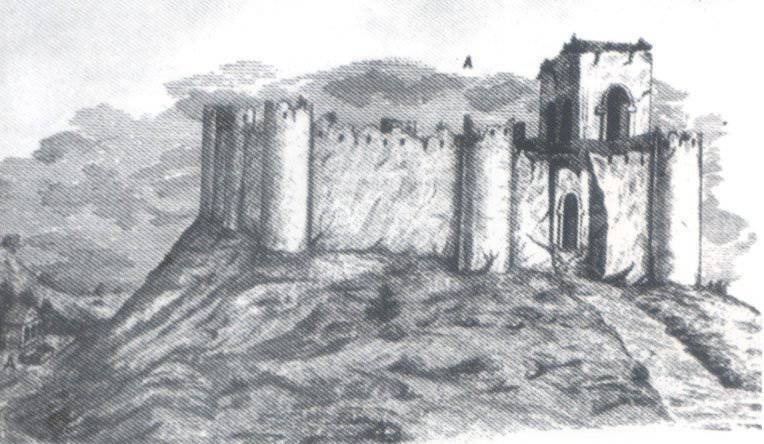
Castle Shahbulag. Sketch of the Russian military historian V. Potto. 1901 year
At night, the Russian soldiers left the fortress. The sentries created the appearance of the presence of the garrison, and were the last to leave with the help of Armenian guides, who conducted their mountain trails. Karyagin received news of the approach of the main forces of Feth Ali Shah. Karyagin’s detachment, with its seat in a small fortress, which had no strategic significance, held the Persian cavalry for many days, which stood still instead of going to Elizavetpol and further to Tiflis. And at this moment Tsitsianov in Elizavetpol practically had no troops, which only came from Tiflis.
During the march of the Karyagin detachment, a very characteristic case occurred: it was necessary to force the ditch to get away from the enemy cavalry, then several soldiers (one of them was Gavril Sidorov), silently jumped into the ditch and created a “living bridge” for their guns from their bodies. . Only two climbed back.
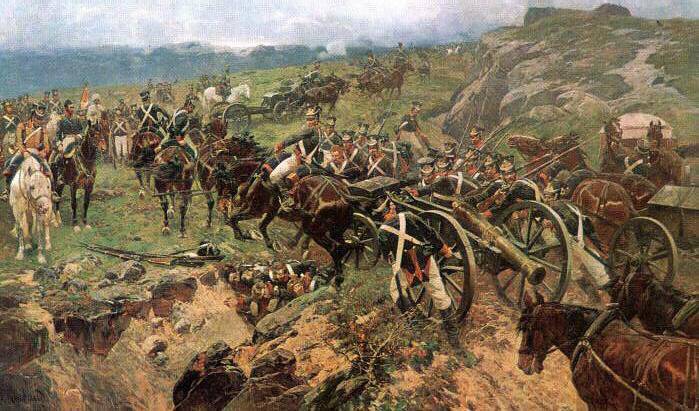
"Living Bridge" Franz Rubo. An episode is depicted when, for transporting the guns, we had to organize a living bridge from the bodies of the soldiers.
On the river Askerani, the Persian cavalry overtook the rangers and musketeers of Karyagin. The Russian detachment took a position on the banks of the river Askarani, on a high hill, where there was a large Muslim cemetery with numerous tombstones and small mosques with minarets, which facilitated the defense. For several days, a handful of Russian brave men restrained the onslaught of 20-thousand. Persian horde, to which constantly arrived reinforcements. Persians, emboldened by a small number of Russians, constantly attacked. On the third day, the Persians cut off Karyagin's detachment from the river, installing several batteries with falcontes (small-caliber guns) on the bank.
Despite the heavy losses (in the first, most fierce battles, almost half of the detachment lay), thirst and desperate situation, the Russian soldiers still managed to make forays. In one of these attacks, the team of Lieutenant Ladinsky with a quick blow cut out the first Persian battery, then captured the second in a fierce hand-to-hand fight, and on the third and fourth, the Persians simply fled, frightened by Russian bayonets. Russian soldiers seized water and seized 12 falconets.
The actions of Karyagin's detachment bound most of the enemy army, which enabled Tsitsianov to wait for reinforcements and go on the offensive. In fact, Karyagin saved Georgia with his resistance. The troops from Tiflis arrived at Yelizavetpol, and Major General Tsitsianov 11 July moved to Karabakh. 15 July Russian troops forced the river Tartar. The Persian army under the leadership of Feth Ali Shah chose to retreat behind the Araks, without getting involved in a decisive battle. The fortress of Shusha and the detachment of Colonel Karyagin were unlocked.
Only Abbas-Mirza's cavalry remained in Northern Azerbaijan. The Persian prince decided on a detour. He and his cavalry walked around the Russian troops and marched on Elizavetpol. However, a small garrison of several hundred soldiers, Cossacks and Armenian volunteers repelled the attack of the Persian cavalry. Abbas-Mirza retreated to Shamkhor and decided to stir up an uprising among local residents and strike Tiflis, which was practically without protection. Meanwhile, a detachment of Colonel Karyagin approached Elizabeth, who was sent to rest.
Colonel Karyagin with several hundred infantry would not be able to catch up with the enemy cavalry. Fortunately, the accidental circumstance detained the cavalry of Abbas-Mirza on the spot. The Persians in the area of Dzegam encountered a small transport marching from Tiflis to Elizavetol, which was guarded by 300 soldiers. Russian soldiers and Georgian drovers built field fortifications from loaded carts, and held defenses for several days. In the evening of July 27, Karyagin’s squad struck a sudden blow to the Abbas-Mirza camp. The defense of the enemy was broken through, its artillery captured. Not allowing the Persians to come to their senses and take advantage of the numerical advantage, the Russian soldiers deployed guns and opened fire on the enemy cavalry. The Persian army was completely demoralized and fled. Russian trophies were guns, all the property in the Persian camp and the wagon train. Prince Abbas-Mirza fled across the Araks River.
After this, Tsitsianov began to subdue the neighboring owners. The Tsitsianov governor planned to occupy Baku and establish itself in the southern part of the Caspian Sea. But in order to ensure communications going from Tiflis to the Caspian, it was necessary to solve the issue of the Shirvan Khanate. Tsitsianov began negotiations Mustafa Khan. He did not refuse directly, but was in no hurry to fulfill the requirements of Tsitsianov. All summer there were negotiations, but they did not bring success. Mustafa maneuvered between Russia and Persia. 30 November 1805, the Tsitsianov detachment crossed the Kuru and invaded Shirvan. December 27 Shirvan Khan Mustafa Khan signed an agreement on the transition to Russian citizenship. The transfer of a strong Shirvan khanate to the arm of Russia further weakened Tehran’s positions in the Transcaucasus.
In the same 1805, Tsitsianov tried to bring the Baku Khanate under control. Summer Caspian flotilla under the command of Major General Irinarkh Zavalishin, she came out of Astrakhan and moved south along the coast of the Caucasus. As part of the land landing was 1300 soldiers under the command of Lieutenant Colonel Aseev. The main task of the flotilla was to capture Gilan, a wealthy Iranian province, in order to divert Persian forces from the main theater of operations. Baku was originally planned to take on the way back. Russian troops easily occupied Anzeli, the main Persian port on the Caspian Sea. The Persians surrendered the port city to the enemy with virtually no battle. However, Rasht failed to capture. For almost a month there was an expedition on the Gilan shore. Russian troops fought almost every day with an adversary who received large reinforcements. Meanwhile, unbearable heat and high humidity did more harm to the Russian detachment than the Persians. Hundreds of soldiers are out of order. Zavalishin decided to return.
On the way back, Zavalishin tried to take Baku. 12 August 1805, the Caspian Flotilla anchored in Baku Bay. Hussein Kuli Khan (Hussein Kuli Khan) refused to accept Russian citizenship. During 11 days, the Caspian flotilla bombarded the fortress, but weak naval artillery could not do much damage to the powerful Baku fortress. The landing party landed on the shore achieved some success, defeated the Khan army in open battle and seized the advanced fortifications. However, the heavy losses from the clashes on the Persian coast, and from epidemics forced Zavalishin in early September to lift the siege. In addition, the troops of Derbent Khan Sheikh Ali and Surkhay Khan Kazikumyk were approaching Baku. This failure greatly distressed Tsitsianova. He believed that Zavalishin did not do everything possible to win and decided to take the Baku Khanate himself.
Campaign 1806 of the year. The siege of Baku and the death of Tsitsianov
Tsitsianov, in spite of a serious illness and gloomy forebodings, decided to punish the owner of Baku, who had earlier sworn Russia and violated it. At the beginning of 1806, the prince of Tsitsianov with 2-thousand. detachment approached Baku (Gilyan expedition. The siege of Baku and the death of Tsitsianov). At the same time, the Caspian Flotilla approached Baku and again landed troops. The Tsar's governor began the Baku expedition in the winter, in order to rule out the possibility of the appearance of the Persian army. In winter, it was almost impossible to fight in the mountains.
Baku Khan Gusey-Kuli agreed to take Russian citizenship. However, 8 (20) in February 1806 at the ceremony of the peaceful surrender of Baku, Prince Tsitsianov and his translator, Lieutenant Colonel Prince Elizabar Eristov were treacherously killed. Tsitsianov did not take with him a large convoy, having gone only with a translator and one Cossack, so as not to cause fears of the Baku Khan. Tsitsianov’s head and hands were sent to the Shah of Persia. It is not known exactly who initiated the murder. According to one version, the Baku Khan Huseyn-Kuli knew about the preparation of the assassination attempt on Prince Tsitsianov. According to another version, the murder was organized by two Persian Khans, who looked after Huseyn Quli Khan, and acted through Khan’s cousin Ibrahim Bey, who hated a relative and harassed the authorities. It was Ibragim who killed Tsitsianov with a sudden shot from a pistol. Huseyn Khan did not know about the plot. Ibrahim fled to Tabriz, where he handed over the head to Tsitsianov to the Persians.
Unfortunately, Zavalishin was not up to par in this situation. He was shocked by the tragedy and led the troops. Although the officers of the detachment demanded to immediately go to the storming of Baku and avenge the dastardly murder of Tsitsianov.
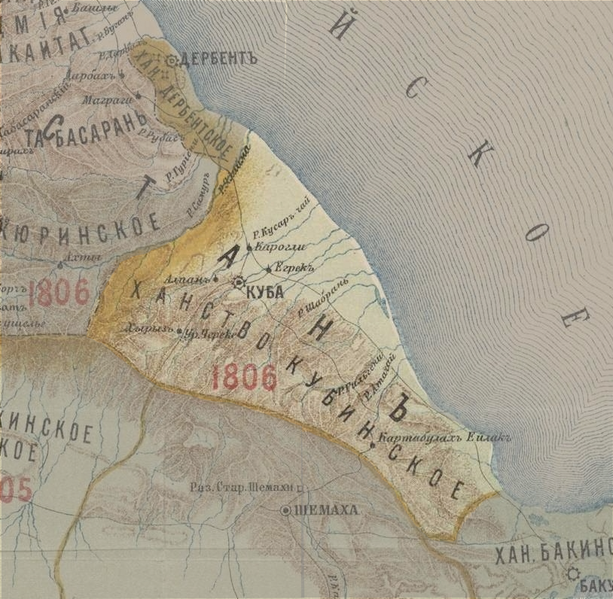
Cuban Khanate on the map of the Caucasus region with the designation of the boundaries of 1806,
Conquest of Derbent, Baku and Cuban Khanates
The death of Commander Tsitsianov and the unsuccessful siege of Baku complicated the situation in Transcaucasia. Georgia found itself in a situation of no beginning and uncertainty. The troops were left without an experienced commander. The authority of Russia among the Caucasian rulers was undermined. Thus, the uprising began in the Shirvan and Sheki khanates. Active mountain tribes. The Persians hastily prepared a new invasion.
A firm hand was needed that would restore order in the Russian domains and successfully continue the war in the Caucasus. Fortunately, such a person was quickly found. Even before the arrival of the new commander-in-chief, the Russian troops were headed by the commander of the Caucasian line, General Grigory Ivanovich Glazenap (1751 — 1819). In 1804-1805 Glazenap successfully opposed the mountain tribes.
General Glazenap decided to strike at Derbent and Baku in order to restore the situation in the South Caucasus and show the Caucasian rulers that the betrayal of Russia would not go unpunished (Conquest of Derbent, Baku and Cuban Khanates in 1806). In June 1806, the troops of Glazenap occupied Derbent. Residents of the city, not wanting to fight for Khan, raised a rebellion. Khan escaped from the fortress. The general accepted the keys to Derbent, and the townspeople were sworn to Emperor Alexander Pavlovich.
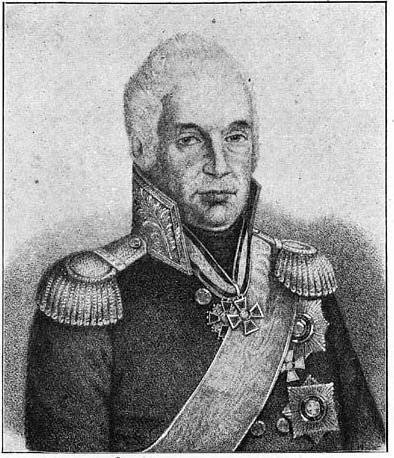
Grigory Ivanovich Glazenap
After that, on orders from Gudovich, a detachment of General Sergei Bulgakov moved to Baku. He had to punish the Bakuites for the treacherous murder of Prince Tsitsianov. Approaching Baku, Bulgakov suggested that the residents lay down their arms, relying on the mercy of Tsar Alexander. In case of resistance, the general promised to destroy the city. Bakuvians brought Bulgakov with the keys to the city. Hussein Kuli Khan, fearing revenge, fled with his family to Cuba and then to Persia. 3 October 1806 Russian troops entered Baku. The participants in the Tsitsianov murder were exiled to Siberia. Baku Khanate was liquidated.
After that, the Russian troops moved to conquer the Cuban Khanate. The ruler of the Khanate Sheikh Ali Khan fled to the mountains. Inhabitants of the Cuban Khanate also submitted and took the oath of allegiance to Russia in November 1806. Thus, thanks to the decisive actions of Glazenap and Bulgakov, the Derbent, Baku and Cuban khanates were included in the Russian Empire.
In the same year, Russian troops successfully repelled a new invasion of the army of the Persian prince Abbas-Mirza. In June, a Russian detachment under the command of Petr Nebolsin (1600 soldier) twice defeated 20-thousand. Persian army. Persians ousted from Karabakh. The Persian army again went beyond the Araks River. At the same time, Russian troops repelled an invasion attempt by Erivan.
Count Ivan Vasilievich Gudovich (1741 - 1820), honored veteran, hero of the Anapa assault in 1791, well-known in the Caucasus, was appointed to the place of Tsitsianov who was killed. Ivan Gudovich distinguished himself in the Russian-Turkish wars 1768 — 1774 and 1787 — 1792. In 1791, he was famous for the assault of "Caucasian Ishmael" - Anapa (Storming "Caucasian Ishmael"). He also twice commanded the Caucasian line - during the reign of Catherine II and Paul. However, old age and the time spent in inaction, spoiled his character. Irritable and vain Gudovich saw some mistakes in Tsitsianov’s activities. Glazenap he did not like and immediately removed from command.
Gudovich faced a difficult task: to wage war on two fronts with weak forces — against the Persian empire and the Ottoman Empire (with which the war began), to maintain order in the newly captured lands. All of the Caucasus was on the verge of an explosion. The Imeretian king rebelled. Frequent Lezgins raids on Georgia. Ossetians were worried. The Zakuban highlanders and Kabardians, taking advantage of the fact that the Russian troops were tied up by the war, made bold raids down to Stavropol. The Persian command was preparing for a new invasion, planning to recapture Karabakh and Ganj.
The uprising began in Sheki khanate. Khan Selim took hostage Major Parfenov, the commander of the garrison, who was in his possession. He released him on the condition that the Russian garrison was withdrawn from the region. The uprising of the ruler of Nuhi led to the uprising of the Jaro-Belokansky Jamaats. The Shaki army and the Jaro-Belokans began to prepare the invasion of Georgia. However, Nebolsin crushed the troops of Selim. Russian troops laid siege to Nuha. Nebolsin suggested Khan to obey and surrender. Selim refused. Russian soldiers stormed the fortress. Then Nebolsin and the commander of the Alazansky line, Prince Dmitry Orbeliani, attacked Lezgins. The Russian troops squeezed all the Lezgi forces, together with the Avars who had approached them to help, in a close Jar gorge. Highlanders were forced to capitulate.
With the pacification of the mountaineers, the 1806 campaign of the year was completed. The Russian command was forced to shift all attention to Turkey. Uzun-Kilissu truce concluded with the Persians. Both sides did not have the strength to continue the war and were preparing for new hostilities. The fighting resumed only in 1808 year.
To be continued ...
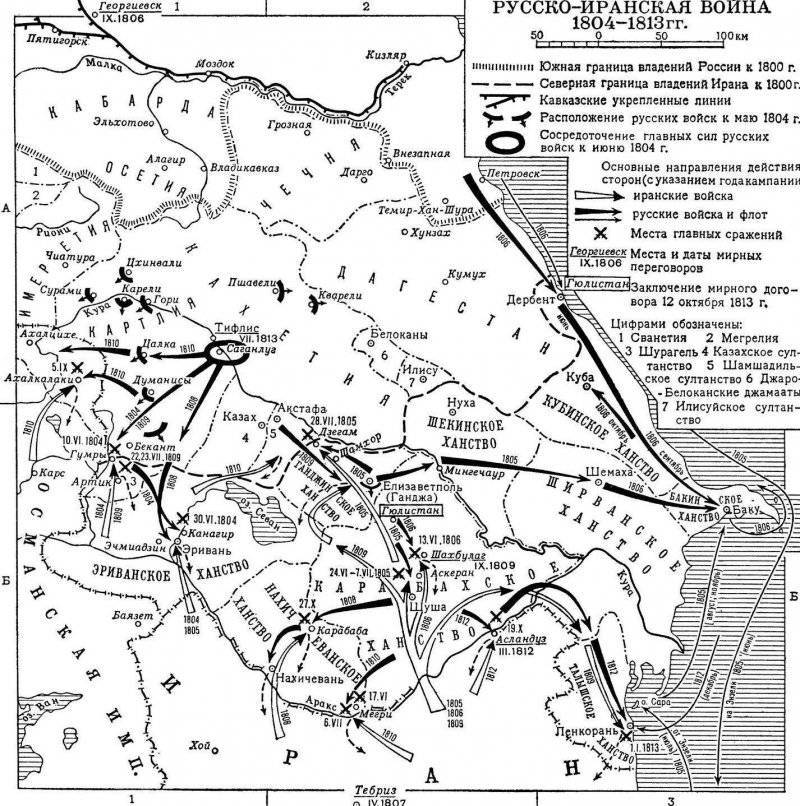
Information